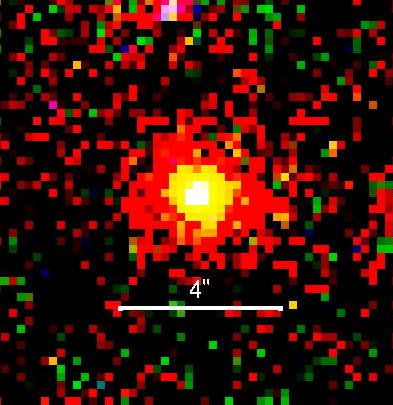

Composite pseudo-color image of the QSO (CFHQSJ2329-0301). The RGB colors are assigned to z0; zr and i0-bands, respectively. The figures are north up, east left. Credit: Goto et al.
[/caption]
A long time ago in a galaxy far, far away there was a supermassive black hole….. Astronomers from the University of Hawaii have spotted a giant galaxy surrounding the most distant supermassive black hole ever found. The galaxy, so distant that it is seen as it was 12.8 billion years ago, is as large as the Milky Way galaxy and harbors a supermassive black hole that contains at least a billion times as much matter as our Sun.
“It is surprising that such a giant galaxy existed when the Universe was only one-sixteenth of its present age,” said Dr. Tomotsugu Goto, “and that it hosted a black hole one billion times more massive than the Sun. The galaxy and black hole must have formed very rapidly in the early Universe.”
Knowledge of the host galaxies of supermassive black holes is important in order to understand the long-standing mystery of how galaxies and black holes have evolved together. Until now, studying host galaxies in the distant Universe has been extremely difficult because the blinding bright light from the vicinity of the black hole makes it more difficult to see the already faint light from the host galaxy.
The origin of the supermassive black holes remains an unsolved problem, and this new device and its findings could open a new window for investigating galaxy-black hole co-evolution at the dawn of the Universe.
A currently favored model requires several intermediate black holes to merge. The host galaxy discovered in this work provides a reservoir of such intermediate black holes. After forming, supermassive black holes often continue to grow because their gravity draws in matter from surrounding objects. The energy released in this process accounts for the bright light emitted from the region around the black holes.
A careful analysis of the data revealed that 40 percent of the near-infrared light observed (at the wavelength of 9100 Angstroms) is from the host galaxy itself and 60 percent is from the surrounding clouds of material (nebulae) illuminated by the black hole.
The scientists results will be published in the journal Monthly Notices of the Royal Astronomical Society later in September. Their paper is available here.
Source: RAS
If you were Captain of the first USS Enterprise, where would you go!? Humanity is…
Now is the best time to observe Mars in 2025. Mars from 2014. Credit: Paul…
Scheduled for launch in 2027, the Nancy Grace Roman Telescope is slowly being readied for…
Few places in the solar system are better suited to a balloon than Titan. The…
We reported before about a NIAC-funded project known as the Lofted Environment and Atmospheric Venues…
The InSight Lander arrived on Mars in 2018 to study the planet's interior. Its mission…